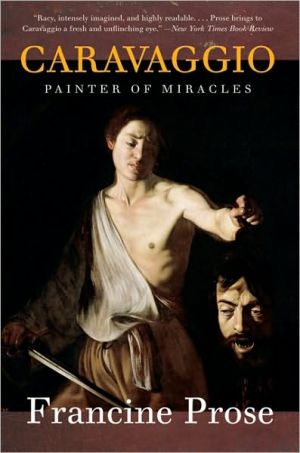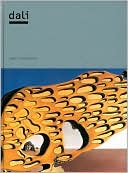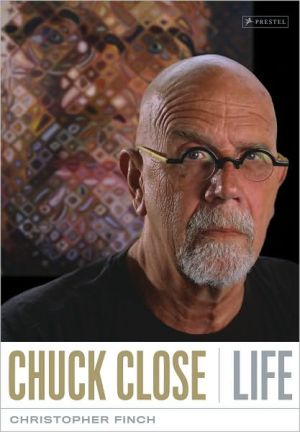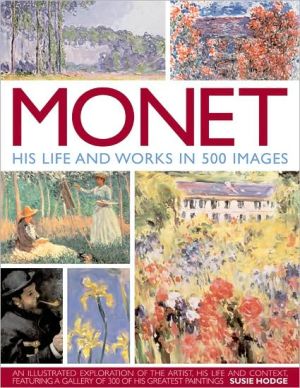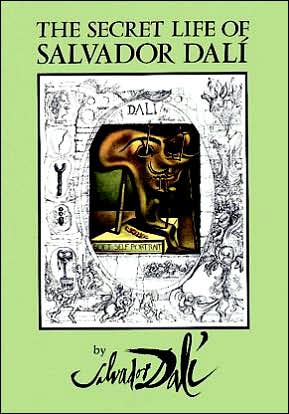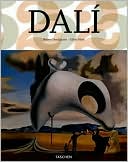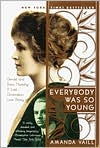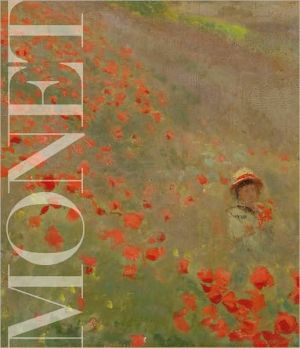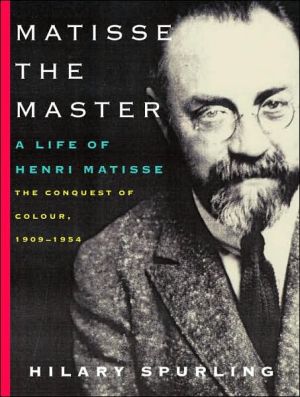Caravaggio: Painter of Miracles (Eminent Lives Series)
Francine Prose's life of Michelangelo Merisi (da Caravaggio) evokes the genius of this incomparable artist through a brilliant reading of his paintings. Caravaggio's use of ordinary people, realistically portrayed—street boys, prostitutes, the poor, the aged—was a profound and revolutionary innovation that left its mark on generations of artists. Revered and successful, Caravaggio was protected by powerful patrons, yet he was also a man of the street who couldn't free himself from its brawls...
Search in google:
Francine Prose's life of Caravaggio evokes the genius of this great artist through a brilliant reading of his paintings. Caravaggio defied the aesthetic conventions of his time; his use of ordinary people, realistically portrayed -- street boys, prostitutes, the poor, the aged -- was a profound and revolutionary innovation that left its mark on generations of artists. His insistence on painting from nature, on rendering the emotional truth of experience, whether religious or secular, makes him an artist who speaks across the centuries to our own time. Born in 1571 near Milan, Michelangelo Merisi (da Caravaggio) moved to Rome when he was twenty-one years old. He became a brilliant and successful artist, protected by the influential Cardinal del Monte and other patrons. But he was also a man of the streets who couldn't seem to free himself from its brawls and vendettas. In 1606 he fled Rome, apparently after killing another man in a dispute. He spent his last years in exile, in Naples, Malta, and Sicily, at once celebrated for his art and tormented by his enemies. Through it all, he produced masterpieces of astonishing complexity and power. Eventually he received a pardon from the Pope, only to die, in mysterious circumstances, on the way back to Rome in 1610. Francine Prose presents the brief but tumultuous life of one of the greatest of all painters with passion and acute sensitivity.The New York Times Book Review - Christopher BenfeyWith his short life and shorter fuse, Caravaggio is a tantalizing subject for a brief biography. He is a major figure…with an almost nonexistent paper trail…A novelist's tools are as necessary here as a biographer's: an imaginative reconstruction of events, a credible portrayal of Caravaggio himself. And Prose, a superb novelist and occasional art critic, has provided both.
Caravaggio\ Painter of Miracles \ \ By Francine Prose \ HarperCollins Publishers, Inc.\ Copyright © 2005 Francine Prose\ All right reserved.\ ISBN: 0060575603 \ \ \ Chapter One\ \ He was thirty-nine when he died, in the summer of 1610. He had been in exile, on the run, for the last four years of his life. He slept fully clothed, with his dagger by his side. He believed that his enemies were closing in on him and that they intended to kill him.\ He was wanted for murder in Rome, for stabbing a man in a duel that was said to have begun over a bet on a tennis game. It was not the first time that he had been in trouble with the law. He had been sued for libel, arrested for carrying a weapon without a license, prosecuted for tossing a plate of artichokes in a waiter's face, jailed repeatedly. He was accused of throwing stones at the police, insulting two women, harassing a former landlady, and wounding a prison guard. His contemporaries described him as mercurial, hot-tempered, violent.\ Michelangelo Merisi, known as Caravaggio, was among the most celebrated, sought after, and highly paid painters in Rome. But not even his influential patrons could arrange for the murder charge to be dismissed. After the crime, he fled to the hills outside the city, and then to a village near Palestrina, where he could have lived safely under the protection of the Colonna family, who were among his patrons, and beyond the range of papal jurisdiction. But the bucolic small town must have seemed dull compared to the chaotic street life of the Campo Marzio, to the taverns, the whorehouses, the gang fights, and -- most important for Caravaggio -- the fierce, energizing competition with his fellow artists, most of whom he despised.\ In Rome, he had seized every opportunity, however impolitic or inappropriate, to criticize his contemporaries and to advance his own ideas about the true purpose of art -- ideas he held with the force of a fanatical conviction and that fueled his erratic behavior, his vertiginous descent from wealth into vagrancy, and his ultimate self-destruction. In retrospect, his contempt and impatience seem more understandable: the frustration of a genius surrounded by a great deal of very bad, very popular, very lucrative and respected art.\ During the years he spent in flight, he painted almost constantly. And despite or because of the impossible pressures and makeshift working conditions, his art became even more ambitious, darker and more deeply shadowed. Months after the murder, he turned up in Naples, where he completed two major altarpieces and a number of smaller canvases. But once again he grew restless. Perhaps he was being followed, or perhaps he just thought so. In any case, he felt that he had no choice but to leave the city.\ Sometime before, he had challenged his former employer and subsequent rival, Giuseppe Cesari, the Cavaliere d'Arpino, to a duel. The cavaliere had replied that, as much as he would have liked to fight, his status as a Knight of Malta prevented him from participating in pointless street brawls with men who, not being knights, were beneath him. Now, as Caravaggio decided where to go after Naples, the old insult may possibly have factored in to his decision to sail to Malta. He would become a Knight of Malta, he would join the Order of Saint John of Jerusalem, a confraternity of soldiers who took monastic vows of poverty and chastity and who pledged to defend the Christian faith. Also he may have heard that the Maltese were seeking a painter to decorate the Cathedral of Saint John in Valletta.\ His experience in Malta established a pattern that would be repeated throughout his exile from Rome. Because his fame had preceded him, and thanks to his contacts in the Maltese capital, he was welcomed by the local nobility and given prestigious commissions. He painted furiously, brilliantly. Driven by his belief in the importance of working from nature, he employed live models whom he posed in theatrical tableaux re-creating scenes from the New Testament and from the lives and deaths of the early Christian martyrs. Always, he reimagined these dramas in novel ways that reached beyond the conventions of art to tap directly into the power and resonance of biblical narrative, and to engage the viewer with an immediacy that made these dramas of suffering and salvation seem comprehensible and convincing. Often ahead of his patrons, the people responded to an art that reminded them that these miracles had transpired neither in primary colors, nor in brilliantly hued paintings of sanitized saints and celestial fireworks, but in dusty streets and dark rooms much like the streets and rooms in which they lived.\ Inevitably, his work was widely discussed, passionately admired or hated, and his fees increased along with his reputation. As he traveled, awaiting the pardon that might enable him to return to the capital, he seemed to have found a way of surviving, of supporting himself and practising his art away from the reliably generous patrons and the distracting intrigues of Rome. And then, just as inevitably, something would go wrong.\ So, in Valletta, he succeeded in having himself appointed a Knight of Malta -- not an easy task, since the honor was mostly reserved for sons of the nobility. Doubtless his knighthood had something to do with the influence of his supporters in Rome, and with the magnificent portrait he did of the grand master of the Knights of Malta, Alof de Wignacourt. But again the artist's situation took a sudden and drastic turn for the worse. Caravaggio insulted a fellow knight, a superior, and was imprisoned in the notoriously escape-proof fortress, Valletta's Castel Sant'Angelo.\ Caravaggio escaped. Pursued, he believed, not only by the pope's men but now also by a posse of vengeful Maltese knights, whose military code of honor had been grievously affronted, he fled to Sicily. In Syracuse, he was reunited with Mario Minniti, a close friend and fellow artist who had served as Caravaggio's model and with whom he had lived in Rome. During his sojourn in Syracuse, Caravaggio painted The Burial of Saint Lucy for the church of Santa Lucia, where the virgin martyr had originally been entombed.\ \ Continues...\ \ \ \ Excerpted from Caravaggio by Francine Prose Copyright © 2005 by Francine Prose.\ Excerpted by permission.\ All rights reserved. No part of this excerpt may be reproduced or reprinted without permission in writing from the publisher.\ Excerpts are provided by Dial-A-Book Inc. solely for the personal use of visitors to this web site. \ \
\ From Barnes & NobleMichelangelo Merisi da Caravaggio packed such recklessness and violence into his short life (1571-1610) that one wonders how he found any time for art. National Book Award finalist Francine Prose argues, however, that the real drama of Caravaggio was played out on canvas, not in Roman back-alley brawls. To prove her point, she probes masterpieces like The Calling of St. Matthew and The Supper at Emmaus to reveal a tumultuous spirit wrestling with his faith.\ \ \ \ \ Seattle Times"Tautly written and insightful."\ \ \ U.S. News & World Report"Everything a casual reader needs to know about flamboyant Baroque artist Caravaggio... Makes you want to go to the museum."\ \ \ \ \ Los Angeles Times Book Review"In this engaging and informative short biography . . . Prose vividly brings [Caravaggio’s] paintings to life."\ \ \ \ \ Hartford Courant"Elegant . . . [Prose] fills out the intrigue of Caravaggio’s own life and writes terrifically about the paintings."\ \ \ \ \ Entertainment Weekly"Combines astute examination of his work with just a plain good yarn about a street tough who painted transcendent pictures."\ \ \ \ \ Booklist"Prose’s concentrated interpretation... clearly and descriptively explicates the pioneering painter’s unique perception of the miraculous in everyday life."\ \ \ \ \ Boston Sunday Globe"Matching gorgeous prose to gorgeous artworks, Prose responds to each image as a moment of theatrical revelation, sensual or spiritual."\ \ \ \ \ New York Times Book Review"Racy, intensely imagined, and highly readable . . . Prose brings to Caravaggio a fresh and unflinching eye."\ \ \ \ \ Entertainment Weekly“Combines astute examination of his work with just a plain good yarn about a street tough who painted transcendent pictures.”\ \ \ \ \ Booklist“Prose’s concentrated interpretation... clearly and descriptively explicates the pioneering painter’s unique perception of the miraculous in everyday life.”\ \ \ \ \ Boston Sunday Globe“Matching gorgeous prose to gorgeous artworks, Prose responds to each image as a moment of theatrical revelation, sensual or spiritual.”\ \ \ \ \ New York Times Book Review“Racy, intensely imagined, and highly readable . . . Prose brings to Caravaggio a fresh and unflinching eye.”\ \ \ \ \ Seattle Times“Tautly written and insightful.”\ \ \ \ \ Hartford Courant“Elegant . . . [Prose] fills out the intrigue of Caravaggio’s own life and writes terrifically about the paintings.”\ \ \ \ \ U.S. News & World Report“Everything a casual reader needs to know about flamboyant Baroque artist Caravaggio... Makes you want to go to the museum.”\ \ \ \ \ Los Angeles Times Book Review“In this engaging and informative short biography . . . Prose vividly brings [Caravaggio’s] paintings to life.”\ \ \ \ \ Christopher BenfeyWith his short life and shorter fuse, Caravaggio is a tantalizing subject for a brief biography. He is a major figure…with an almost nonexistent paper trail…A novelist's tools are as necessary here as a biographer's: an imaginative reconstruction of events, a credible portrayal of Caravaggio himself. And Prose, a superb novelist and occasional art critic, has provided both.\ — The New York Times Book Review\ \ \ \ \ Publishers WeeklyThe first thing to know about this life of the Italian baroque painter Caravaggio is that it is not a proper biography but rather an informal appreciation by novelist and occasional art critic Prose (Blue Angel). As with the other volumes in the Eminent Lives series, groundbreaking research is not expected. Fair enough. Yet despite her obvious love for the artist, Prose has little of substance to say about him. Once she dispatches with the basic points of the artist's life-that Caravaggio defied the fashion for mannered, pious painting with a gritty but theatrical realism that mirrored the artist's turbulent life-she resorts to the puffed-up style of a student trying to reach a term paper's required length. She stuffs her pages with redundant adjectives ("wan, exhausted, used up," "constant and unchanged") and finds no point too trite to repeat three times: "You can watch an artist realizing that what he is doing is succeeding, that the paint is doing precisely what he wants it to do, that his intention and purpose are finding their way onto the canvas." Even those with only a casual interest in the artist would be better served by Helen Langdon's 1998 biography Caravaggio: A Life, which is as accessible as it is scholarly and is now out in paperback. (Oct.) Copyright 2005 Reed Business Information.\ \ \ \ \ Library JournalThis biography of 17th-century Italian painter Caravaggio (1571-1610) is part of HarperCollins's "Eminent Lives" series of brief, compelling biographies on canonical figures by distinguished authors. Novelist and National Book Award finalist Prose (A Changed Man) aims to provide an engaging, general introduction to the popular and influential artist for a wide range of readers by touching on all aspects of Caravaggio's life and works. While to a limited extent she covers the social and historical contexts that may have largely shaped his career, she mainly focuses on his artwork, often giving subjective, inconsistent, and insufficiently documented insights about the man and the patrons of his many oil paintings. Including a bibliography of mostly English-language academic references but lacking chapters, endnotes, and an index, this nonscholarly text belongs in public libraries that wish to augment their art collections with a highly readable and concise though in many ways nonauthoritative account of the painter's life and works. [Forthcoming in the series is Edmund Morris's Ludwig van Beethoven, scheduled for release in October. Future titles will feature Bill Bryson on Shakespeare, Karen Armstrong on Muhammad, and Christopher Buckley on Mark Twain.-Ed.]-Cheryl Ann Lajos, Free Lib. of Philadelphia Copyright 2005 Reed Business Information.\ \ \ \ \ Kirkus ReviewsThe life of the 17th-century "sinner-saint" artist Caravaggio. Capturing the brevity and paradox of her subject's life, National Book Award finalist Prose takes on an artist as loathed in his own time as any modern artist since. Today, however, Caravaggio is considered part of the canon, an artist whose works draw admirers to out-of-the-way places. Novelist Prose (A Changed Man, March 2005, etc.) leads us on the artist's odyssey from the small town of Caravaggio, to Milan, Rome, Naples, Malta, Sicily, back to Naples, and finally to Porto Ercole, where he died of a fever. She excels in relaying what little we know of the artist's personality, a complex mix of undoubted charisma but with an almost psychopathic urge for self-destruction. Caravaggio had an attraction to rough trade, which belied his role as the live-in artist for one of the most cultured and civilized ecclesiastical salons of Rome. The author tracks that personality in Caravaggio's art-his work went from sexy and alluring to so realistic that, when he emerged as an independent artist, many in the establishment thought it vulgar. But it was his ability to illustrate eternal truths by use of the everyday, the mundane, the specific, that made him so popular with those who instinctively understood his art. To many, Caravaggio was merely a copyist, one finding inspiration among the most base members of society; it was inconceivable that Caravaggio would use a dead prostitute for the model of the dead Virgin, despite a result that is today considered one of the most captivating of Baroque paintings. A fine biography-and a study of why revolutionary art can be reviled in its own time and revered in another.\ \
